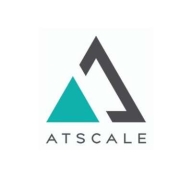

SAP HANA and AtScale Adaptive Analytics A3 compete in the analytics and data management domain, each offering distinct advantages. SAP HANA's high-performance in-memory platform gives it an edge in speed and data processing, while AtScale A3's flexible analytical capabilities and cost-effectiveness often make it the preferred choice for value-driven businesses.
Features: SAP HANA features high-performance real-time analytics, advanced data processing, and a robust security framework. AtScale A3 provides flexible data modeling, compatibility with multiple BI tools, and strong cloud integration.
Ease of Deployment and Customer Service: SAP HANA offers a comprehensive deployment process that may require significant configuration. AtScale A3 simplifies deployment with support for hybrid architectures. SAP HANA offers extensive technical support, while AtScale A3 provides more targeted assistance.
Pricing and ROI: SAP HANA's higher initial setup costs accompany substantial long-term ROI for complex environments. AtScale A3 requires a lower upfront investment and emphasizes rapid time-to-value, making it more cost-effective for businesses with existing BI setups.

AtScale is the leading provider of intelligent data virtualization for big data analytical workloads, empowering citizen data scientists to accelerate and scale their business’ data analytics and science capabilities and ultimately build insight-driven
AtScale connects people to live disparate data without the need to move or extract it, leveraging existing investments in big data platforms, applications and tools. AtScale creates automated data engineering using a single set of semantics so consumers can query live data (either on premise or in the cloud) in seconds without having to understand how or where it is stored—providing security, governance and predictability in data usage and storage costs.
Benefits:
No data movement: AtScale is agnostic to data platforms and data location, whether on-premises or in the cloud, in a data lake or a data warehouse.
Automatic “smart” aggregate creation: AtSacle’s intelligent aggregates adapt to the data model and how it is used, automating the data engineering tasks required to support those activities and reducing time spent from weeks to hours.
Use your existing BI and AI tools: AtScale provides access to live, atomic-level data without the user needing to understand where or how to access the data, so you can keep using your tools of choice.
No more extracts or shadow IT: AtScale eliminates the need for extracts with a single, consistent, governed view of live data, regardless of which BI and AI tools are used.
Data-as-a-service: AtScale allows metadata to be created once, with centrally defined business rules and calculations, exposing data assets as a service.
Data platform portability: Models built in AtScale are portable, with no need to recreate them for different platforms. AtScale can easily be repointed to new data platforms, making migration seamless to business users.
Faster time-to-insight: AtScale reduces time-to-insight from weeks and months to minutes and hours. AtScale virtual models can be created and deployed in no time, with no ETL or data engineering.
Future-proof your data architecture: AtScale alleviates the complexities of data platform and analytics tool integration, making cloud, hybrid-cloud and multi-cloud data architectures a reality without compromising performance, security, agility or existing governance and security policies.
Features:
Design CanvasTM: AtScale’s Design Canvas visually and intuitively connects to any data platform, allowing you to create virtual multidimensional cubes without ETL.
Autonomous Data Engineering: Just-in-time query optimization that anticipates the needs of the data consumer.
Universal Semantic LayerTM: A workspace with a Design Canvas for your data consumers to define business meaning and get a single-source-of-truth.
Security & Data Governance: Centralized security policy to decentralize access using the tenants of Zero Trust.
Virtual Cube Catalog: A gateway to data that is easily discoverable and frictionless—and available to use every day, en masse.
AtScale connects people to live disparate data without the need to move or extract it, leveraging existing investments in big data platforms, applications and tools. AtScale creates automated data engineering using a single set of semantics so consumers can query live data (either on premise or in the cloud) in seconds without having to understand how or where it is stored—providing security, governance and predictability in data usage and storage costs.
SAP HANA, also known as SAP High-performance Analytics Appliance, is a multi-model database that stores data in its memory, allowing users to avoid disk storage. The product combines its robust database with services for creating applications. SAP HANA is faster than other database management systems (DBMS) because it stores data in column-based tables in main memory and brings online analytical processing (OLAP) and online transaction processing (OLTP) together.
The column-oriented in-memory database design allows users to run high-speed transactions alongside advanced analytics, all in a single system. This provides companies with the ability to process very large amounts of data with low latency and query data in an instant. By combining multiple data management capabilities, the solution simplifies IT, helps businesses with innovations, and facilitates digital transformation.
The solution is structured into five groups of capabilities, categorized as:
There are three more SAP products that work alongside SAP HANA and complete the experience for users together. SAP S/4HANA Cloud is a ready-to-run cloud enterprise resource planning (ERP). SAP BW/4HANA is a packaged data warehouse, based on SAP HANA, which allows users to consolidate data across the enterprise to get a consistent view of their data. Finally, SAP Cloud is a single database as a service (DBaaS) foundation for modern applications and analytics across all enterprise data. All three products can combine with SAP HANA to deliver to users an optimized experience regarding their data.
SAP HANA Features
Each architectural group of capabilities of SAP HANA has various features that users can benefit from. These include:
SAP HANA Benefits
SAP HANA provides many benefits for its users. These include:
Reviews from Real Users
According to a database consultant at a pharma/biotech company, SAP HANA is a very robust solution with good data access.
Bruno V., owner at LAVORO AUTOM INF E COM LTDA, likes SAP HANA because the product offers advanced features, helps reduce hours, and makes it easy to find what you need.
We monitor all Data Virtualization reviews to prevent fraudulent reviews and keep review quality high. We do not post reviews by company employees or direct competitors. We validate each review for authenticity via cross-reference with LinkedIn, and personal follow-up with the reviewer when necessary.